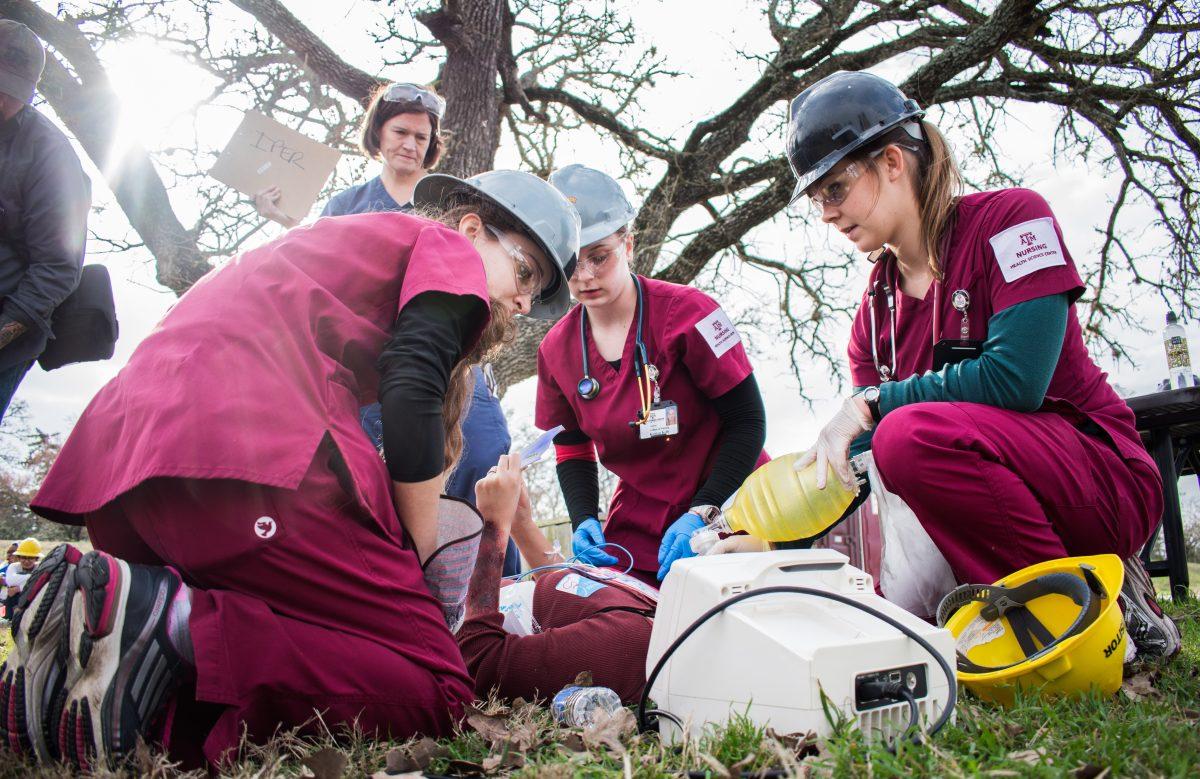With smoke rising, victims sobbing and medical personnel rushing to the scene, the 10th annual Disaster Day emergency scene was in full swing Friday.
The Texas A&M University Health Science Center simulated a train derailment to give students first hand experience in disaster response at the Texas A&M Engineering Extension Services (TEEX) Brayton Fire Training Field and Disaster City. The decade old event earned its title as the largest student-led interprofessional emergency response exercise in the nation this year, with over 650 students from the College of Medicine, College of Nursing, Rangel College of Pharmacy, School of Public Health and the College of Veterinary Medicine and Biomedical sciences. Due to its size, this is the first year Disaster Day was held at the 52-acre mock city emergency responder training facility.
While practical medical skills were valuable lessons learned at the event, communication and team work were key, according to Jared Laney, first year medical student and Disaster Day deputy incident commander and public information officer.
“The primary thing that we want to accomplish at Disaster Day is working on interdisciplinary collaboration,” Laney said. “Studies have shown that one of the biggest causes of medical errors is lack of communication, so we want to facilitate an environment here where the public health personal, nursing personnel, medical personnel and vet med and everybody work together to make the right thing happen for the patients in this disaster.”
The change in location was not only a way to accommodate the event’s growth, but also a chance for students to be in a more more accurate disaster environment, according to Jay Maddock, dean of the School of Public Health.
“We wanted to make it as realistic as possible,” Maddock said. “When everybody is in a gym, it’s hard to feel like there is a real disaster. We have the premier disaster site in the nation here on campus, so to be able to bring students and really have the feel of getting onto the trains and removing students, having incident command set up really makes it come to life for students and really appreciate what it’s like in a true disaster.”
This is the first year students have the chance to see the disaster played out rather than simply working in a trauma center setting, according to Barbara Quiram, professor and director of the preparedness center at the School of Public Health.
“This is a wonderful opportunity for our students across the health science center in all the colleges to be able to have that exposure to what an emergency event actually looks like and feels like and the things they might be called upon to do outside of a normal or traditional healthcare setting,” Quiram said.
Disaster Day has provided students with an experience to look back on after graduation, according to Madison Johnson, nursing senior and Disaster Day incident commander.
“We’ve had students in the past come back and tell us after they graduated that they were in a disaster scenario in a hospital or wherever they were working and said this day helped prepare them for what they were going through and allowed them to be a leader in their field,” Johnson said.
Dealing with disaster
February 16, 2018
0
Donate to The Battalion
$2065
$5000
Contributed
Our Goal
Your donation will support the student journalists of Texas A&M University - College Station. Your contribution will allow us to purchase equipment and cover our annual website hosting costs, in addition to paying freelance staffers for their work, travel costs for coverage and more!
More to Discover










